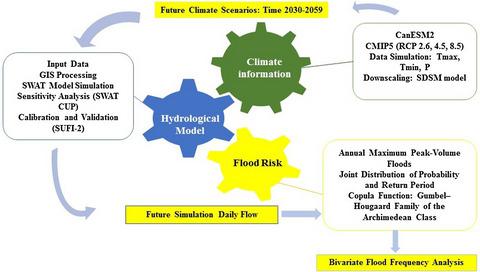当前位置:
X-MOL 学术
›
Water Environ. J.
›
论文详情
Our official English website, www.x-mol.net, welcomes your
feedback! (Note: you will need to create a separate account there.)
Predicting Future Flood Frequency Under Climate Change Using Copula Function
Water and Environment Journal ( IF 1.7 ) Pub Date : 2020-04-19 , DOI: 10.1111/wej.12572 Mohammad Reza Goodarzi 1 , Atiyeh Fatehifar 2 , Ali Moradi 3
Water and Environment Journal ( IF 1.7 ) Pub Date : 2020-04-19 , DOI: 10.1111/wej.12572 Mohammad Reza Goodarzi 1 , Atiyeh Fatehifar 2 , Ali Moradi 3
Affiliation

|
The joint behaviour of flood variables under climate change is of high importance for the economics of projects and risk reduction. This study investigates the implications of climate change using Gumbel–Hougaard copula function for future bivariate of flood peak and volume variables, in Azarshahr chay watershed. Canadian Earth system model (CanESM2) under three Representative Concentration Pathways (RCPs) along with statistical downscaling method (SDSM) and soil and water assessment tool (SWAT) were adopted to assess both baseline (1976–2005) and future (2030–2059) periods. Bivariate analysis of Copula improved the accuracy of model with an average NSE of 0.97 for all scenarios. Joint return period for severe floods has declined in the future, especially in RCP8.5. For a constant discharge and volume, joint return periods at the base period, RCP2.6, RCP4.5 and RCP8.5 were 24, 10, 13 and 9 years, respectively. Multivariate analysis may also provide useful information for flood risk assessment.
中文翻译:

利用Copula函数预测气候变化下的未来洪水频率。
气候变化下洪水变量的联合行为对于项目的经济性和降低风险具有重要意义。这项研究使用Gumbel–Hougaard copula函数研究气候变化对Azarshahr柴河流域未来洪峰和流量变量的二元变量的影响。采用加拿大地球系统模型(CanESM2)的三个代表性浓度路径(RCP)以及统计缩减法(SDSM)和土壤和水评估工具(SWAT)来评估基线(1976-2005)和未来(2030-2059)期。Copula的双变量分析提高了模型的准确性,所有方案的平均NSE为0.97。未来,特别是在RCP8.5中,严重洪灾的联合遣返期有所减少。对于恒定的流量和体积,在基准周期RCP2处有联合返回周期。6,RCP4.5和RCP8.5分别为24、10、13和9岁。多变量分析还可为洪水风险评估提供有用的信息。
更新日期:2020-04-19
中文翻译:

利用Copula函数预测气候变化下的未来洪水频率。
气候变化下洪水变量的联合行为对于项目的经济性和降低风险具有重要意义。这项研究使用Gumbel–Hougaard copula函数研究气候变化对Azarshahr柴河流域未来洪峰和流量变量的二元变量的影响。采用加拿大地球系统模型(CanESM2)的三个代表性浓度路径(RCP)以及统计缩减法(SDSM)和土壤和水评估工具(SWAT)来评估基线(1976-2005)和未来(2030-2059)期。Copula的双变量分析提高了模型的准确性,所有方案的平均NSE为0.97。未来,特别是在RCP8.5中,严重洪灾的联合遣返期有所减少。对于恒定的流量和体积,在基准周期RCP2处有联合返回周期。6,RCP4.5和RCP8.5分别为24、10、13和9岁。多变量分析还可为洪水风险评估提供有用的信息。











































 京公网安备 11010802027423号
京公网安备 11010802027423号